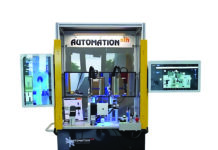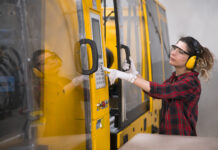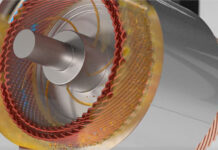
You’ve probably seen them sprouting from the landscape or seashore. The white rotors of these modern-day windmills slowly turn in hypnotic unison, making it hard to believe wind turbines produce much electricity. But that is their sole purpose, and they do it well. According to the U.S. Energy Information Administration, a typical wind turbine installed in 2020 creates enough electricity in 46 minutes to power the average U.S. home for one month. That kind of power generation wouldn’t be possible, however, without the turbine’s rotors – the blades or airfoils – that harness the power of the wind.
Airfoil Design Challenges
The technology and engineering behind these expansive wing-like appendages are the expertise of Gulf Wind Technology, a company dedicated to developing rotor design solutions to address current wind turbine limitations and future needs. And like any technology, advancements are often borne out of a desire to improve the status quo or to solve a problem.
To illustrate, the U.S. Gulf Coast presents wind turbine manufacturers with several challenges. Wind velocities are highly variable, ranging from very light to hurricane-force. To find a solution, Gulf Wind Technology partnered with a leading energy company with interests in the region to develop solutions that allow wind turbines to work effectively in both conditions. The resulting collaboration formed the Gulf Wind Technology Accelerator, the most advanced rotor innovation center in the U.S., which utilizes a state-of-the-art technology facility.
But how do you design, validate, and test rotors that can be longer than an American football field? Computational fluid dynamics analysis offers a starting point, which provides a theoretical model. However, validating the mathematical model typically requires wind tunnel tests using scaled-down rotor models. These models are usually CNC machined or formed with a carbon-fiber lay-up applied over a mold. According to Gulf Wind Technology senior product developer Joe Lotuaco, “we’re given a problem statement, and then we’ll scale it down, investigate it, and develop solutions.”
3D Printing Provides a Solution
Manufacturing wind tunnel models with 3D printing offers Gulf Wind Technology several benefits. The first is shortening the design and fabrication cycle, including the time to iterate and finalize the design. Second, 3D printing’s additive nature gives their specialist engineers the unique advantage of incorporating pressure taps directly into the models. These small ports provide essential data on the airfoil’s performance and are very difficult – and sometimes close to impossible – to incorporate in a machined or molded wind tunnel model.
“We’ve been able to design the internal structure of our test articles to have all the pressure taps run to a manifold, which I can just plug into the pressure scanner. Then it’s easy to swap between models,” says Lotuaco. “I don’t see how they could have been done in a traditional way without doing a multiple-section model.”
Another advantage of 3D printing is the wide range of technology choices and compatible materials, ranging from FDM® to powder bed fusion to stereolithography (SLA). For the wind tunnel application, available materials, surface finish, and printer size were among the important decision criteria. After reviewing possible options with the team from Prototyping Solutions, a 3D printing service provider serving the southeast U.S., Gulf Wind Technology chose the Stratasys Neo®800 SLA printer. In particular, the capabilities of the materials helped tip the scale in the Neo’s favor.
PerFORM Reflect Material: The Game Changer
PerFORM Reflect is ideal for wind tunnel testing primarily because of its strength, stiffness, and temperature resistance. These characteristics allow the airfoil models to withstand the wind speeds and resulting loads and surface temperatures they experience during testing. Besides delivering a resilient and slippery aerodynamic surface, PerFORM Reflect reduces the cycle time to produce a test-ready model. Its orange color provides the right finish to minimize light distortion and optimize particle reflection needed for accurate PIV (particle imaging velocimetry) testing. Other materials have to be coated after printing, adding time to the process.
The Proof is in the Results
As is often the case in client work, timelines are tight, and that reality is no different for Gulf Wind Technology. Fortunately, the Neo800’s speed in producing wind tunnel models helps the engineers meet their project deadlines. Lotuaco explains, “When our CEO asked me to put together the business case for 3D printing, I compared it against the traditional methods of CNC machining and composite lay-up. And it always came down to the time factor. Using the Neo to make the same exact airfoil, same geometry and size, was on the order of 2.5 to 5 times faster to print versus composite lay-up or CNC machining.”
PerFORM Reflect’s durability also played favorably with the small air channels used for the airfoil’s pressure taps. Despite their small size, these orifices were also printed with integral threaded connections. “The fact that we can put a decent amount of torque on them without stripping, I think that’s something that is unique with this material,” Lotuaco notes. The ability to print these ports right in the model also speeds up the process. Lotuaco affirmed this benefit, noting that adding these pressure-sensing channels to a traditionally made test article would increase its lead time by several orders of magnitude.
A Technology That Applies to Any Industry
While this might appear to be a story about how 3D printing benefits the wind turbine industry, that’s not the complete picture. At a deeper level, it illustrates what’s possible at the nexus between innovative companies like Gulf Wind Technology and the enabling technology of additive manufacturing.
When Joe Lotuaco learned that Formula 1 race teams use 3D printed wind tunnel models to optimize their cars’ shape, he made the connection with using the same process to refine wind turbine rotor design. The result is a faster, more efficient means of developing the optimal airfoil shape to harness wind power in the Gulf of Mexico.
Looking Ahead
Like most businesses that adopt additive manufacturing, once they grasp its capabilities, new application opportunities seemingly present themselves at every turn. And that usually leads to a broadening of additive capabilities. When asked about Gulf Wind Technology’s plans, Lotuaco sees several possibilities. “One of the things we are looking at down the road is not just getting more SLA capacity, but looking at the different additive technologies that are out there and how we might be able to apply them in the future for other things that we think we’ll need,” he says. “We are looking at metal printing, and we’re looking at the Stratasys FDM machines to print some of the high-performance engineering plastics like ULTEM™, things like that,” he adds.
The scope of available additive technologies and the ever-expanding material capabilities give manufacturers the tools to dramatically change how things are designed, tested, and produced for the better. Gulf Wind Technology recognizes this, leveraging additive technology to help forge a greener future through better wind turbine rotor design. But in the end, it helps differentiate Gulf Wind Technology in its industry space. And it’s a perfect example of how virtually any business in any industry can use additive to capitalize on the advantages and set itself apart.
Joe Lotuaco sums it up this way: “Customers see that we’re not doing things the way they’ve always been done. When they come to our facility and see that we have our own wind tunnel and this (additive) lab setup, that’s unlike anybody else. So I think using (additive) as a tool shows that we are leveraging and using new technologies you don’t typically associate with wind.”


















